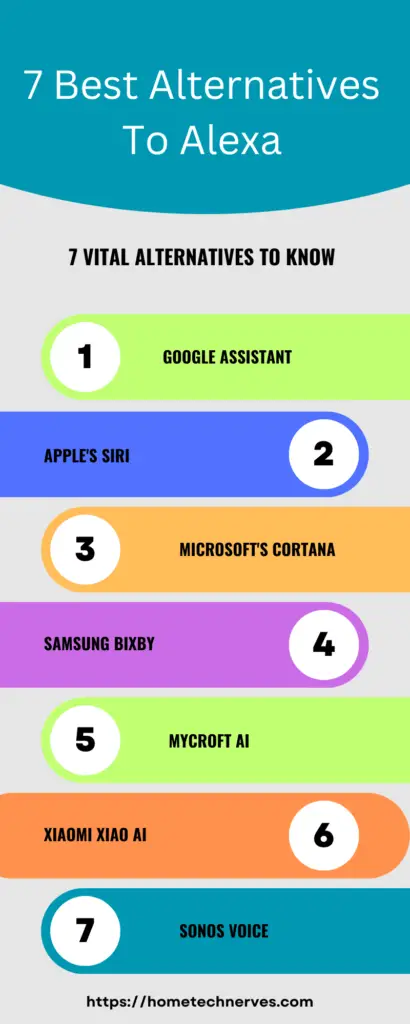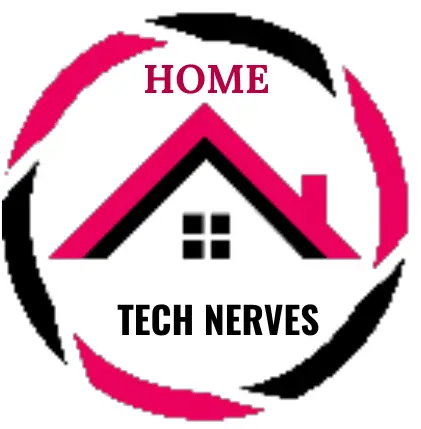As a tech enthusiast who thrives on seamless smart home experiences, I’ve often pondered the question: Is there an alternative to Alexa?
In my quest for the perfect voice-activated assistant, I’ve explored various options beyond Amazon’s ubiquitous AI companion.
From Google Assistant to Apple’s Siri, each contender brings its unique set of features and quirks.
Join me on this journey as we unravel the alternatives, weighing their pros and cons to find the ideal voice assistant that aligns with our preferences and enhances our daily interactions with technology.
Let’s navigate the realm of smart assistants together and discover the best fit for our connected lives.
Table of Contents

8 Best Alternatives to Alexa
As someone deeply entrenched in the world of smart home technology, I’ve explored a multitude of voice-activated assistants beyond the confines of Alexa.
In this guide, I present the top alternatives that not only rival Alexa but also bring unique features to the table, catering to diverse preferences and needs.
1. Google Assistant: Unveiling the Power of Search Giant’s AI
Discover the prowess of Google Assistant as it seamlessly integrates with your daily routine, leveraging the vast knowledge of the search giant to provide accurate and context-aware responses.
- Context-Aware Responses: Leverages Google’s vast database for accurate and context-aware answers.
- Seamless Integration: Integrates effortlessly with Google services and a wide range of third-party devices.
- Natural Language Processing: Recognizes and responds to natural language commands for a more intuitive user experience.
- Routine Automation: Facilitates the creation of custom routines to streamline daily tasks with a single voice command.
- Multi-Device Functionality: Syncs across multiple devices, allowing a consistent experience whether on a smartphone, smart speaker, or smart display.
- Continuous Learning: Evolves by learning user preferences and adapting to individual needs.
2. Apple’s Siri: A Blend of Elegance and Efficiency
Explore the sophisticated world of Siri, where Apple’s commitment to design meets an efficient voice assistant, creating a harmonious ecosystem for Apple device users.
- Design Harmony: Reflects Apple’s commitment to design aesthetics, offering a visually pleasing and user-friendly experience.
- Ecosystem Integration: Seamlessly integrates with the Apple ecosystem, connecting iPhones, iPads, Macs, and more.
- Intelligent Suggestions: Provides intelligent suggestions based on user behavior and preferences.
- HomeKit Control: Manages smart home devices through Apple’s HomeKit, offering centralized control.
- Hands-Free Operation: Enables hands-free operation for various tasks, enhancing user convenience.
- Accessibility Features: Includes accessibility features to cater to a diverse range of users.
3. Microsoft’s Cortana: The Business-Focused Assistant
Delve into the business-centric capabilities of Cortana, Microsoft’s virtual assistant, and explore how it goes beyond casual commands to assist with productivity and organization.
- Productivity Assistance: Goes beyond casual commands to assist with productivity and organizational tasks.
- Office 365 Integration: Seamlessly integrates with Microsoft’s Office 365 suite for enhanced business functionality.
- Calendar Management: Manages schedules and appointments, providing proactive reminders.
- Cross-Platform Compatibility: Functions across various devices, promoting a unified user experience.
- Voice Recognition: Incorporates advanced voice recognition technology for precise command interpretation.
- Skills Development: Allows users to develop custom skills and extend Cortana’s capabilities.
4. Samsung Bixby: Tailored Assistance in the Samsung Galaxy Universe
Embark on a journey through the Samsung Galaxy ecosystem with Bixby, a voice assistant designed to seamlessly integrate with Samsung devices and offer personalized assistance.
- Galaxy Ecosystem Integration: Seamlessly integrates with Samsung’s Galaxy ecosystem for a cohesive user experience.
- Device Control: Enables users to control and interact with Samsung devices using natural language commands.
- Vision Capabilities: Utilizes vision capabilities for image-based search and recognition.
- Contextual Understanding: Understands context to provide relevant and personalized responses.
- Quick Commands: Facilitates the creation of quick commands to streamline repetitive tasks.
- Third-Party Integration: Extends functionality by integrating with select third-party applications and services.
5. Mycroft AI: Open-Source Freedom for Voice Control
Explore the open-source revolution with Mycroft AI, a privacy-centric alternative that empowers users with customization options and the freedom to control their smart home without sacrificing privacy.
- Privacy Focus: Prioritizes user privacy by being an open-source and customizable voice assistant.
- Community Collaboration: Benefits from a community-driven development model, encouraging collaboration and innovation.
- Customizable Skills: Allows users to create and customize skills, tailoring the assistant to individual preferences.
- Platform Agnostic: Works across various platforms, offering flexibility in device choices.
- Voice Command Expansion: Supports expanding voice commands beyond traditional smart home control.
- Offline Functionality: Some versions offer offline functionality, ensuring privacy and availability even without an internet connection.
6. Xiaomi Xiao AI: Bridging Language Barriers and Beyond
In my quest for alternatives to Alexa, the global appeal of Xiaomi Xiao AI caught my attention.
With its proficiency in multiple languages and seamless integration into Xiaomi’s vast Internet of Things (IoT) ecosystem, this voice assistant emerges as a compelling contender for those seeking a comprehensive and multilingual smart home experience.
- Multilingual Capabilities: Excels in understanding and responding in multiple languages, catering to a global user base.
- IoT Integration: Seamlessly integrates with Xiaomi’s extensive ecosystem of Internet of Things (IoT) devices.
- Location-Based Services: Leverages location data for context-aware responses and personalized recommendations.
- Voiceprint Recognition: Implements voiceprint recognition for enhanced security and user-specific interactions.
- Third-Party Skills: Supports third-party skills development, expanding its capabilities beyond built-in features.
7. Sonos Voice: Elevating Audio Control with Intuitive Commands
As someone passionate about audio excellence, I couldn’t overlook the allure of Sonos Voice in my exploration beyond Alexa.
This specialized assistant not only provides intuitive control over Sonos audio devices but also enhances the music discovery experience, making it an appealing choice for audiophiles and music enthusiasts alike.
- Premium Audio Focus: Tailored for Sonos audio devices, allowing users to control speakers and music effortlessly.
- Music Discovery: Offers personalized music recommendations based on user preferences and listening history.
- Room-Specific Commands: Enables users to control audio playback in specific rooms with precise voice commands.
- Seamless Multi-Room Setup: Facilitates easy setup and synchronization for a seamless multi-room audio experience.
- Voice Amplification: Prioritizes clear voice recognition, even amid audio playback, for optimal user experience.
8. Jibo: The Social Robot Companion
In the realm of unconventional alternatives, Jibo stands out as a social robot companion.
Intrigued by its unique approach to human-like interactions, I delved into the world of Jibo, exploring its expressive gestures, social engagement, and educational capabilities.
While not widely available, Jibo adds a distinctive touch to the landscape of voice-activated companions.
- Social Interaction: Stands out as a social robot, engaging users in conversations and responding to emotions.
- Expressive Gestures: Accompanies voice responses with expressive gestures, adding a human touch to interactions.
- Face and Object Recognition: Utilizes advanced recognition technology for facial and object identification.
- Educational Capabilities: Designed to assist with educational tasks and engagingly provide informative content.
- Limited Availability: While not widely available, Jibo offers a unique and personable alternative for those seeking a social companion.
Wrap Up
In the ever-expanding landscape of voice-activated assistants, the journey to find the perfect alternative to Alexa unveils a rich tapestry of options.
From Xiaomi’s multilingual prowess to Sonos’ audio-centric focus and Jibo’s social charm, each alternative caters to diverse preferences.
As a seasoned explorer of tech realms, I’ve witnessed the evolution of these assistants, and the array of choices underscores the dynamism of the field.
The conclusion remains resolute: alternatives to Alexa are plentiful, offering users a diverse range of features and functionalities to suit their unique needs and preferences.
The future of voice assistants promises continued innovation and exciting possibilities.
Frequently Asked Questions
Is there an alternative to Alexa?
Yes, several alternatives to Alexa exist, including Google Assistant, Apple’s Siri, and Samsung Bixby. Each has unique features and device compatibility. Choose the one that aligns with your preferences and integrates seamlessly with your smart home devices.
What are the differences between Alexa and Google Assistant?
Both Alexa and Google Assistant are virtual assistants, but they differ in features, integration, and ecosystems. Google Assistant tends to excel in search capabilities, while Alexa has a vast skills library. Consider your specific needs when choosing between these alternatives
Can I use Siri instead of Alexa?
Yes, Siri is an alternative to Alexa for Apple device users. It operates on iOS devices and HomePods, providing voice-activated assistance. Ensure your smart home devices are compatible with Apple’s HomeKit for optimal integration and control through Siri.
Are there open-source alternatives to Alexa?
Yes, open-source alternatives like Mycroft and Snips.ai offer customizable virtual assistant solutions. These platforms allow users to have more control over privacy and customization. Keep in mind that setting up and maintaining open-source options may require technical expertise.


